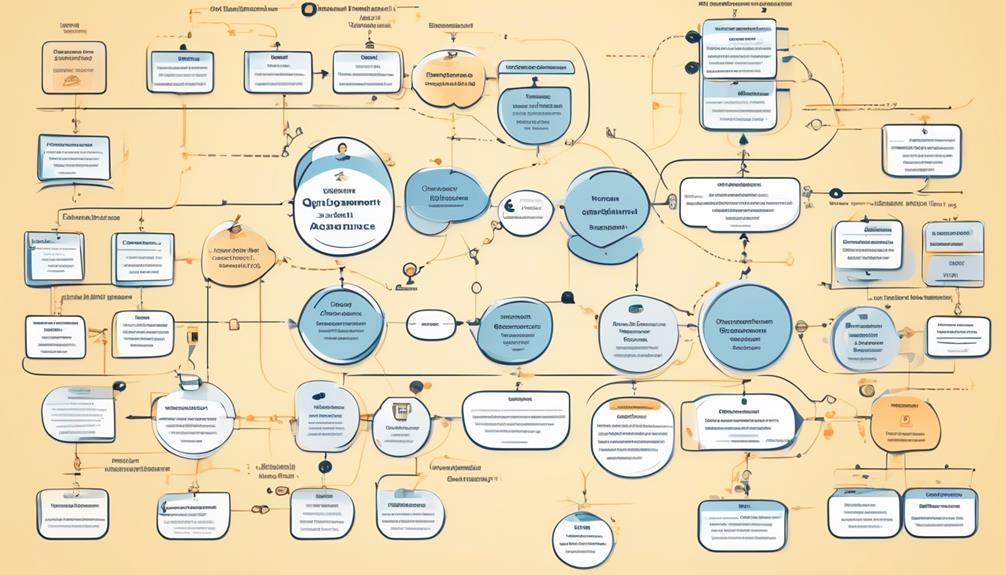Identifying and fixing bugs and defects is crucial for upholding the quality of software. Guaranteeing the software’s reliability and performance is vital for meeting customer demands and remaining competitive in the market.
However, there are numerous factors that contribute to the overall quality of software, and understanding these complexities is essential for successful quality assurance.
As we explore the various dimensions of software quality assurance, we will uncover the key principles and methodologies that drive effective quality assurance practices, ultimately leading to the delivery of dependable and high-performing software products.
Key Takeaways
- Defect prevention is more efficient and cost-effective than correcting them later.
- Adherence to industry standards ensures best practices and enhances software quality.
- Understanding differences and benefits of Waterfall and Agile methodologies is essential.
- Thorough software testing throughout the development life cycle saves time and money.
Principles of Software Quality Assurance
We adhere to five fundamental principles in software quality assurance to ensure:
- Defect prevention: It is more efficient and cost-effective to prevent defects than to correct them later in the software development process.
- Continuous improvement: This is an ongoing process that ensures that our QA processes are always evolving and becoming more effective.
- Stakeholder involvement: It fosters collaboration and communication, ensuring that the software quality attributes meet the needs and expectations of all stakeholders.
- A risk-based approach: It allows us to prioritize significant risks, focusing our efforts on the most critical areas.
- Root cause analysis: It enables us to identify and address the underlying causes of defects rather than just treating the symptoms.
Adhering to these principles ensures that our software quality assurance processes are thorough, methodical, and geared towards delivering high-quality software products.
Importance of Industry Standards

Adherence to industry standards in software development is essential for ensuring best practices, interoperability, legal compliance, and customer confidence. Following industry standards is crucial for maintaining the quality of the software and ensuring that quality assurance processes are effective. It also provides a competitive edge by demonstrating a commitment to excellence and professionalism, thereby fostering customer satisfaction. Here is a table highlighting the importance of industry standards in software quality assurance:
| Importance of Industry Standards | Software Quality Assurance |
|---|---|
| Ensures best practices | Enhances the quality of the software |
| Facilitates interoperability | Improves quality assurance processes |
| Ensures legal compliance | Fosters customer satisfaction |
| Demonstrates commitment to excellence | Provides a competitive edge |
Adhering to industry standards not only contributes to the overall quality of the software but also aligns with quality management systems, ultimately leading to the delivery of reliable and trustworthy software products. Therefore, it is imperative for organizations to prioritize the incorporation of industry standards into their software development processes.
Testing Methodologies for Quality Assurance
Testing methodologies for quality assurance play a crucial role in ensuring the reliability and effectiveness of software products. When it comes to QA processes, understanding the differences and benefits of Waterfall and Agile methodologies is essential for successful software development.
Recognizing the importance of both Black Box and White Box Testing ensures comprehensive quality control, while understanding the significance of Unit Testing and Integration Testing guarantees the quality of code at different levels.
Additionally, acknowledging the importance of Regression Testing and Performance Testing is vital for maintaining quality and ensuring system performance.
Lastly, understanding the advantages and best use cases for Manual Testing and Automated Testing is crucial in ensuring thorough testing for defects and errors in software products.
These testing methodologies are integral for software development teams, as they contribute to the overall quality and success of the software products being developed.
Key Factors in Software Quality Assurance

Ensuring software product quality meets standards requires meticulous attention to key factors in software quality assurance. These factors involve continuous improvement, monitoring and measurement of quality, defect prevention, and external evaluation for efficiency, reliability, and cost of maintenance.
Implementing software quality assurance is crucial throughout the software development lifecycle to ensure a high-quality software product. Continuous improvement is pivotal, as it involves regularly assessing and enhancing processes to optimize quality.
Monitoring and measurement of quality, along with effective defect prevention strategies, are essential for maintaining high standards. Additionally, external evaluation plays a significant role in determining the efficiency, reliability, and cost of maintenance of the software product.
It's important to note that focusing on defect prevention is more efficient than correction after the fact. Testing and quality control are integral aspects of software quality assurance, as they contribute to the overall importance of software quality.
Role of Quality Assurance in Delivering Reliable Software
In our pursuit of delivering reliable software, we focus on continuous monitoring and improvement of processes to identify and eliminate defects and errors in our products. Quality assurance plays a critical role in ensuring thorough testing and high standards before software release.
Here are three crucial aspects of the role of quality assurance in delivering reliable software:
- Thorough software testing throughout the development life cycle ensures that defects and errors are identified and addressed early, saving time and money in the long run.
- Integrating quality assurance into software development processes ensures that quality isn't just verified after production, but is proactively built into the product.
- Effective quality assurance in software focuses on reducing defects and errors, ultimately enhancing the end customer's experience and satisfaction.
Frequently Asked Questions
What Are the Three Most Important Aspects of Quality Assurance in Software Development?
We believe that the three most important aspects of quality assurance in software development are efficiency, reliability, and maintainability.
These aspects ensure that the software performs optimally, consistently delivers accurate results, and can be easily updated and maintained.
What Are the Key Aspects of Quality Assurance?
Key aspects of quality assurance include:
- Rigorous testing
- Stakeholder collaboration
- Continuous improvement
These elements ensure software meets defined standards and user requirements. Our approach prioritizes significant risks in the development process, enhancing efficiency and reliability.
External and internal evaluations are crucial for assessing maintainability and flexibility. Quality assurance functions in parallel with development activities, ensuring a critical component of the software development life cycle.
What Are the 3 Quality Aspects of Software Quality?
In software quality assurance, three key aspects include external evaluation, internal evaluation, and parallel functions to the software development life cycle.
External evaluation encompasses efficiency, reliability, and cost of maintenance.
Internal evaluation focuses on structure, complexity, readability, flexibility, testability, and coding practices.
SQA plays a critical role in ensuring high-quality software for consumers and the product itself, confirming the worthiness of a software product.
What Is the Most Important Thing in Quality Assurance?
The most important thing in quality assurance is ensuring that the software meets the defined quality standards, requirements, and acceptance criteria. Continuous improvement through stakeholder involvement and a risk-based approach is essential for maintaining high quality.
We prioritize root cause analysis of defects, not just symptoms, monitoring and measuring quality, tracking defects, and analyzing metrics.
Conducting reviews by experts not involved in development is a critical practice for effective software quality assurance.
Conclusion
In conclusion, implementing effective software quality assurance processes is essential for delivering reliable software products.
According to a recent survey, companies that prioritize quality assurance in their software development process have reported a 25% increase in customer satisfaction and a 30% decrease in post-release defects.
This statistic highlights the significant impact of quality assurance on the overall success and quality of software products.
It's clear that attention to detail and thorough testing methodologies are crucial for achieving high standards of quality.
Rick, our Software Quality Assurance Writer, is the creative force behind many of our insightful articles and course materials. His unique background in software development, fused with his natural flair for writing, allows him to convey complex QA concepts in a way that is both informative and captivating. Rick is committed to keeping abreast of the latest trends and advancements in software testing, ensuring that our content remains not just relevant, but at the forefront of the field. His significant contributions are instrumental in helping us fulfill our mission to deliver premier QA education.










